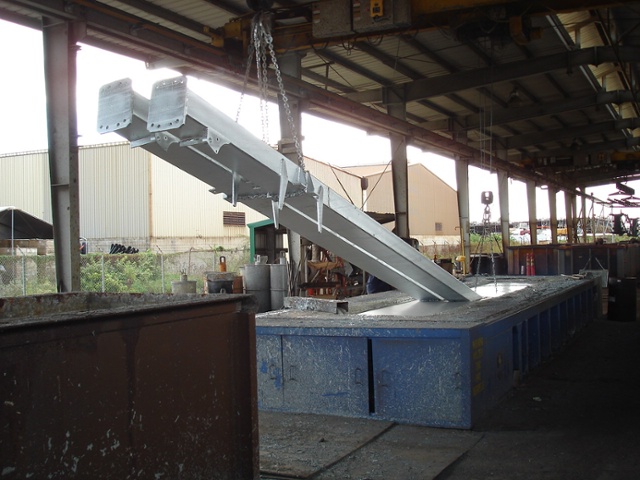

Hot-dip galvanizing dramatically improves the longevity and durability of steel. This is especially important in highly corrosive environments. That is why Kloeckner Metals has a hot-dip galvanizing plant in Hawaii, the only one in the state. Hawaii’s diverse and highly corrosive environment of ocean-salt exposure, high humidity, rain and trade winds create the need for superior corrosion protection.
“It’s ideal for Hawaii’s demanding environment,” says Diane Malinovich, vice president and general manager of Kloeckner Hawaii. “Because of the fact that we are in the middle of the pacific, that salt in the air takes a beating on everything. So by galvanizing steel, it’s going to last very long term.”
Customers bring in a variety of steel parts for galvanizing from rebar to boat trailers. The kettle is 27 feet long, 6 feet deep, and 4 feet wide. Over-length materials can still be galvanized, but sometimes it requires two or even three dips. One of the most interesting things to be galvanized was steel fencing surrounding the Iolani Palace in Honolulu, the only palace in the United States. The fencing was installed in the late 1800s.
The galvanizing process involves dipping the metal into a series of processing tanks, each with its own purpose. Before it enters the tanks, though, the metal needs to be properly prepared.
“The material has to be sandblasted bare when it shows up,” Malinovich says. “If there’s any paint on it, we won’t touch it.”
After that, the metal is cleaned with caustic chemicals. This removes any contaminants on the material, such as dirt, oil, or grease. It is then rinsed and further treated by pickling. Pickling removes mill scale and iron oxides from the surface of the steel. It is rinsed again and then dipped in a flux solution made of a zinc ammonium chloride solution. This removes any additional oxides and creates a protective layer on the metal, making it ready for galvanizing. Galvanizing itself involves dipping the metal into a kettle of molten zinc.
“The zinc in the kettle is kept at about 835 degrees, 24/7,” Malinovich says.
The zinc reacts with the iron in the steel to form metallurgically bonded zinc-iron intermetallic alloy layers. A layer of pure zinc is usually added on top to protect from damage. Once the coating is applied, the metal cools and then is inspected. This ensures a quality coat, free of bare spots.
“There are the pre and post inspections, plus the quality control for putting the parts through the various processing tanks and the kettle,” Malinovich says.
Hot-dip galvanizing provides long lasting corrosion protection by creating a layer of cathodic protection to the metal. Basically, the zinc corrodes instead of the steel. The zinc layer patinas slightly, creating a layer of zinc carbonate that is not water soluble. This corrodes very slowly, protecting the galvanized steel beneath it. The corrosion rate is about 1/30th that of exposed steel in the same environment, according to the American Galvanizers Association.
Even if the surface is scratched, the zinc coating will continue to protect the steel. Even if the bare steel is exposed up to ¼ inch in diameter, it will not begin to corrode until all the surrounding zinc is consumed. It requires no maintenance, further saving long term costs.
“It lasts for generations,” Malinovich says.
Thanks for reading. If you enjoyed this article, you can read more like it on the Kloeckner Metals Blog.
![]()

Steel base plates are fundamental elements employed in various manufacturing...
Metal fabrication is a critical process that transforms raw metal...
The solar industry has undergone a significant transformation by incorporating...

X
The Kloeckner Metals website uses modern technologies. Unfortunately, your browser doesn't support those technologies.
Download the latest version of one of these browsers to experience the site: